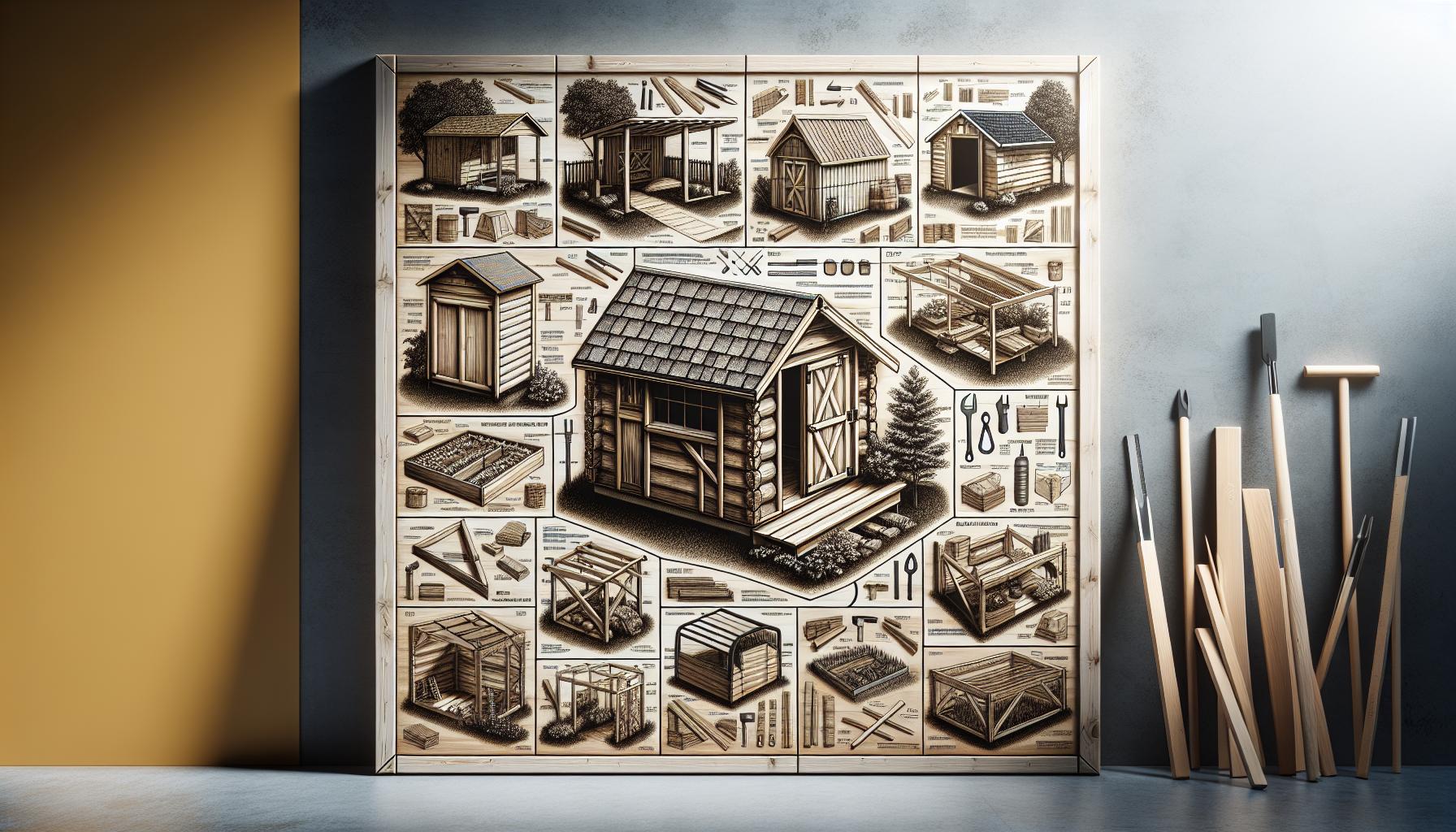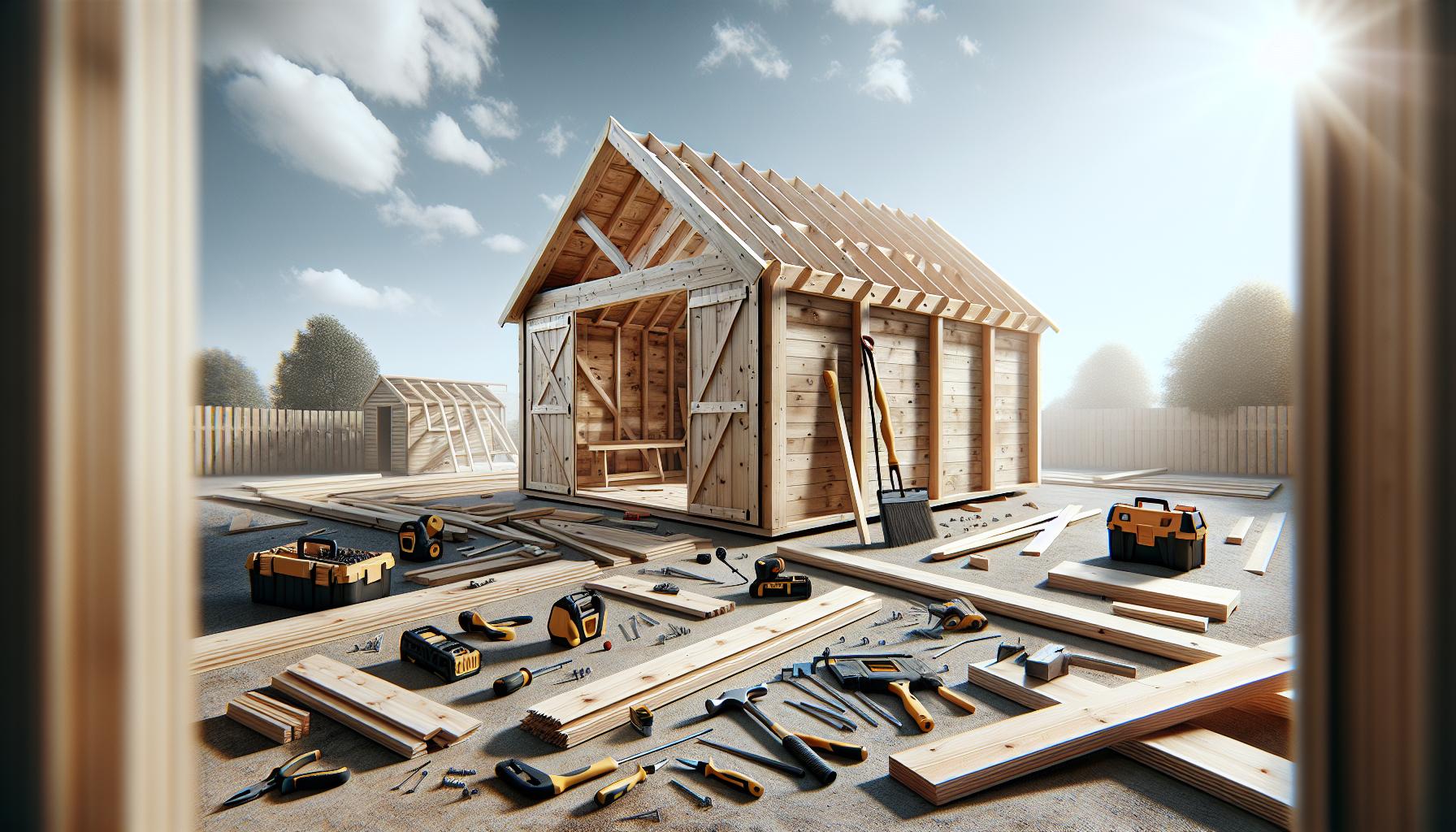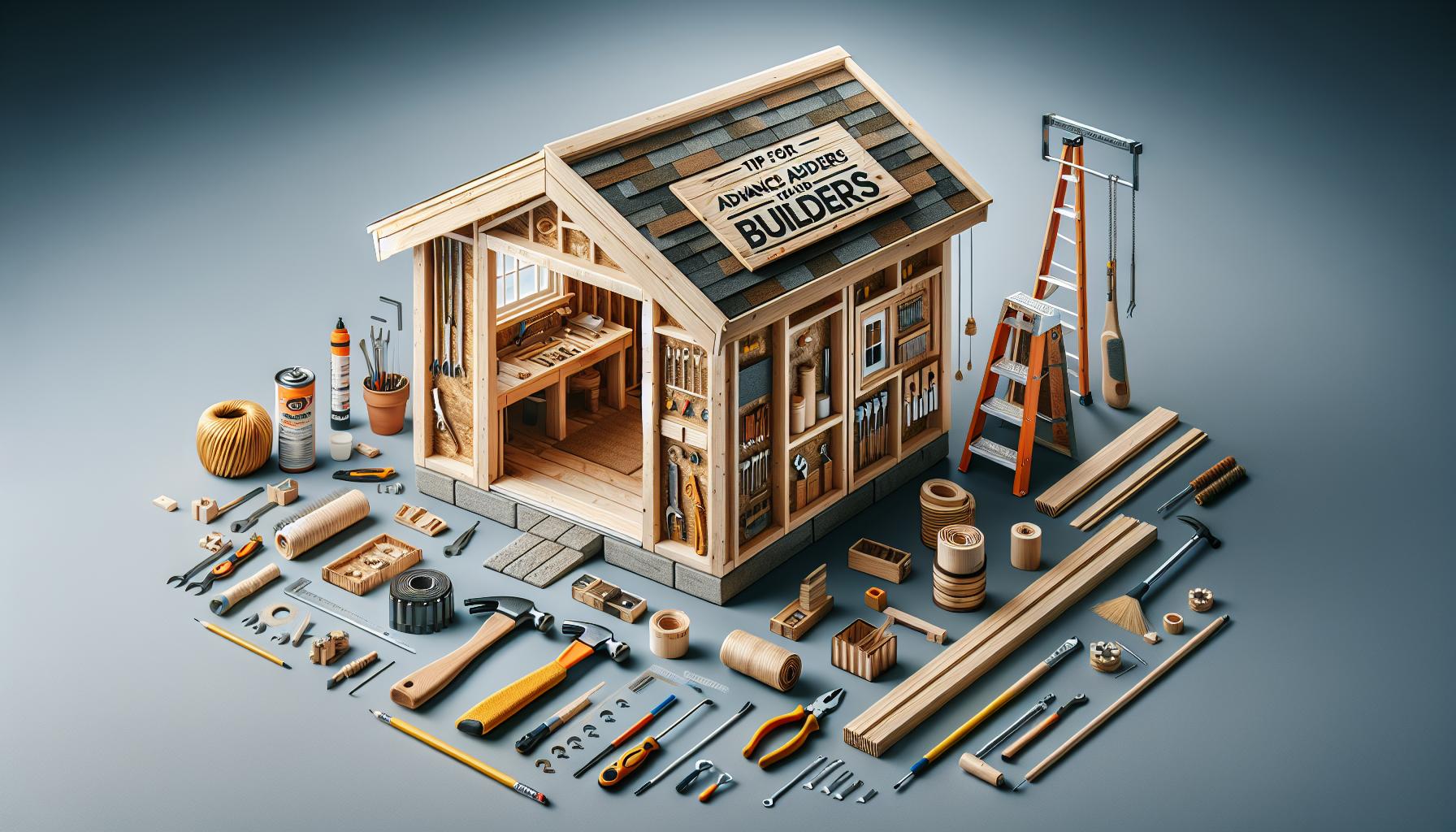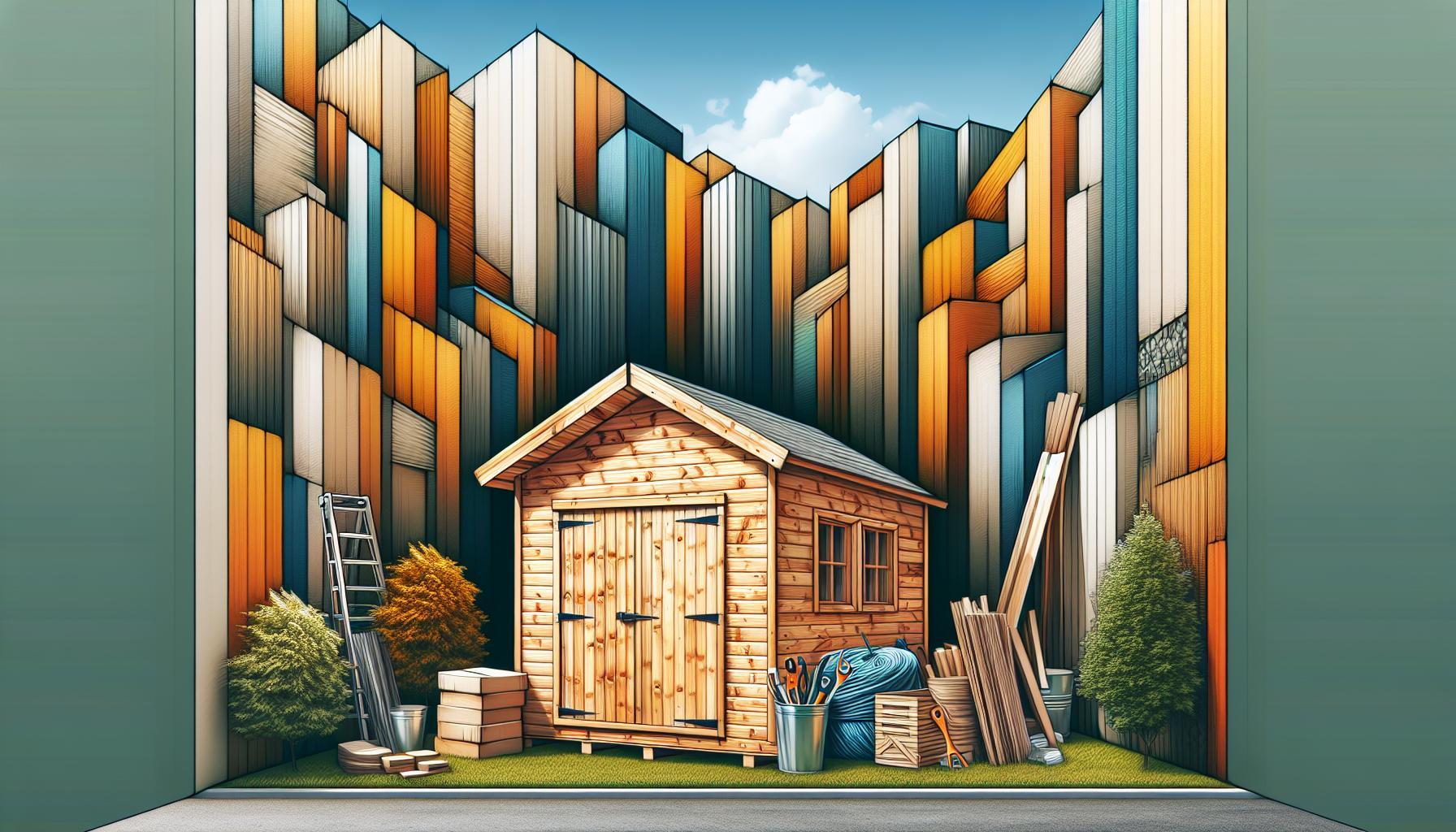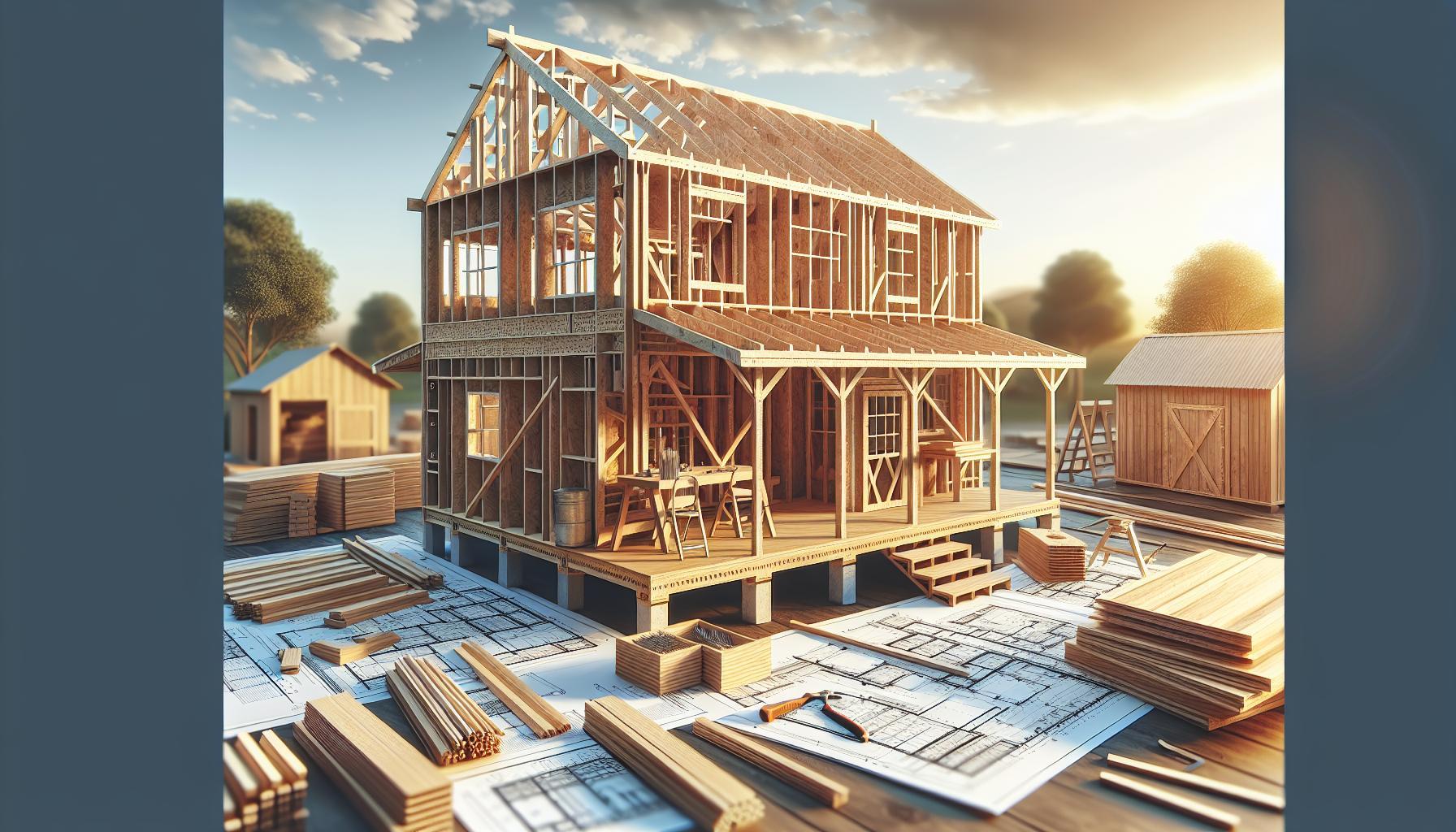Are you dreaming of a backyard shed but unsure where to start? This guide breaks down the construction process, highlighting difficulty levels tailored to every skill set. From novice DIYers to seasoned builders, understanding the various challenges involved in shed assembly can empower you to take on this rewarding project with confidence.
Understanding Your Shed Building Options: A Guide to Materials and Designs
Building a shed is not just an engaging project; it can also boost your property’s functionality and aesthetic appeal. Choosing the right materials and design is pivotal in determining the difficulty of your shed-building experience. This guide will walk you through various options, tailored to different skill levels, enabling you to create a space that not only meets your needs but also aligns with your capabilities.
Materials: The Backbone of Your Shed
Selecting the appropriate materials will substantially influence how easy or complex it is indeed to build your shed.Here are the most common materials to consider:
- Wood: Known for its versatility and customary aesthetic, wood can be shaped and painted to fit any style. While working with wood is accessible for many DIY enthusiasts, it may require more maintenance over time.
- Metal: Often chosen for its durability, metal sheds are immune to rot and pests. They generally have a simpler assembly process,making them a great option for beginners.
- Vinyl: Increasingly popular for its low-maintenance qualities, vinyl is lightweight and resistant to fading. However, it may not offer the same structural strength as wood or metal.
- Composite: A blend of recycled materials, composite sheds combine aesthetic appeal with durability. they are lightweight and provide a lower environmental impact.
for visual learners, consider the following table that compares key attributes of these materials:
| Material | Durability | Maintenance | Skill Level Required |
|---|---|---|---|
| Wood | moderate | High | Intermediate |
| Metal | High | Low | Beginner |
| Vinyl | High | Very Low | Beginner |
| Composite | Moderate to High | Low | Intermediate |
Design Considerations: tailoring to Your Skills
Beyond materials, the design of your shed will also impact the building process. Here are a few popular designs categorized by skill level:
- Basic shed: A simple rectangular shape, easily constructed with straightforward plans. Ideal for novices, this design typically features a single door and an apex roof.
- Gable shed: Slightly more complex,this design includes a peaked roof for better rain runoff. it’s great for intermediate builders looking to add character to their shed.
- Williamsburg Shed: Perfect for those who want to showcase their craftsmanship, this design includes intricate features like overhangs and dormer windows, challenging even skilled carpenters.
- Custom Designs: For seasoned builders, personalizing shed plans allows for creativity and maximization of space according to unique needs.
Understanding your options in materials and designs not only equips you with the necessary knowlege to plan your shed project but also ensures your building experience is tailored to your particular skill level. Whether you’re a beginner or a seasoned pro, there’s a perfect shed for you waiting to be built!
Skill levels Decoded: Which Shed Style Is Right for You?
When considering the construction of a shed, a key factor that often gets overlooked is matching the shed style to your skill level. Many budding DIYers find themselves overwhelmed by the vast array of designs available, from simple storage solutions to elaborate workshop setups. The right choice not only influences the overall aesthetic of your yard but also determines whether the build will be a fulfilling experience or a frustrating endeavor. Understanding your own skills and the complexity of each shed style can make all the difference in your project’s success.
Understanding Skill Levels
Before diving into specific shed styles, it’s essential to categorize the skill levels associated with building a shed. Here’s a breakdown:
| Skill Level | Description | Example Shed Style |
|---|---|---|
| Beginner | Basic knowledge of tools; can follow step-by-step instructions. | Lean-to Shed |
| intermediate | Some prior experience in construction; comfortable with power tools. | Gable Shed |
| Advanced | strong building skills; has completed multiple projects. | Floor-to-ceiling Workshop shed |
| Expert | professional-level skills; can create custom designs from scratch. | Custom Cabin Shed |
Choosing the Right Shed Style
Your skill level should guide your choice of shed style to ensure that the project is not only achievable but also enjoyable. For those just starting, a Lean-to Shed is a fantastic choice due to its straightforward design and minimal material requirements. It typically involves a single sloped roof and straight walls, making it a great entry-point project without overwhelming complexity.
conversely, if you have a bit more construction experience, consider a Gable Shed. Its classic design features two sloped roof sections that meet at the top and offer ample interior space. This type is still relatively easy to construct while providing a more finished appearance that can enhance your property’s value.
For seasoned builders, Floor-to-Ceiling Workshop Sheds allow for creativity and advanced techniques such as framing and roofing variations.These structures frequently enough require excellent planning and precision, making them ideal for those looking to showcase their skills.
if you’re at an expert level, crafting a Custom Cabin Shed can be immensely satisfying. This involves personalized designs, perhaps incorporating windows, electrical work, and intricate details. Keeping in mind the principles of building codes and permits is essential for a professional finish.reflecting on your abilities and comfort level with tools can significantly streamline your shed-building journey. Choose a style that not only speaks to your aesthetic desires but also aligns with your construction expertise. By matching your skills with the right shed design,you’re more likely to create a structure that you’ll be proud of for years to come.
Essential Tools & Equipment: what you Need for Every Difficulty Level
When embarking on your shed-building journey,understanding the essential tools and equipment you’ll need is crucial for success—regardless of your skill level. not only do the right tools make the process smoother, but they also empower you to tackle projects that may have once felt daunting. Whether you’re a seasoned DIY enthusiast or a complete novice, having a well-equipped workspace will enhance your building experience and help bring your vision to life.
Basic Tools for Beginners
For those just starting out, simplicity is key. Here’s a list of essential tools you should have on hand:
- Tape Measure: Accurate measurements are crucial for any construction project.
- Level: A good level ensures that your shed will stand straight and true.
- handsaw: Perfect for making precise cuts on wood without the complexity of power tools.
- Hammer: A basic tool that’s essential for driving nails into your shed frame.
- Drill: Battery-operated or corded drills speed up the process of making holes and driving screws.
These basic tools not only help in constructing a shed but also lay down the foundation for a lifetime of DIY projects.
Intermediate Tools for the Aspiring DIYer
As your skills grow, you might find yourself ready to tackle more complex projects.To elevate your building capabilities, consider acquiring the following equipment:
- Circular Saw: A versatile power tool that allows for faster and straighter cuts compared to a handsaw.
- Stud Finder: This tool is invaluable for locating joists or studs in walls, a must when erecting any structure.
- Clamps: Keep your pieces securely in place while you work, ensuring accuracy and stability.
- Safety Gear: Always prioritize safety with glasses,gloves,and ear protection,especially when working with power tools.
These tools empower you to handle a range of projects more confidently, paving the way for more innovative and complex designs.
Advanced Tools for the expert Builder
For those looking to refine their craft and tackle professional-grade projects,investing in high-quality tools is essential. The following advanced equipment can enhance your building experience:
- Table saw: Provides precise cuts and is ideal for larger pieces of wood.
- Miter Saw: Great for making angled cuts, ideal for framing and trim work.
- Router: Adds decorative edges and grooves for a professional finish.
- Portable Generator: Ensures you have power even in the most remote locations.
Whether your goal is to create a simple garden shed or a work of art that fits perfectly in your yard, these advanced tools will give you the versatility and precision you need.
| skill Level | Basic Tools | Intermediate Tools | Advanced Tools |
|---|---|---|---|
| Beginner | Tape Measure, level, Handsaw, Hammer, Drill | N/A | N/A |
| Intermediate | Tape Measure, Level, Handsaw, Hammer, Drill | Circular Saw, Stud Finder, Clamps, Safety Gear | N/A |
| Expert | Tape Measure, Level, Handsaw, Hammer, Drill | Circular Saw, Stud Finder, Clamps, Safety gear | Table Saw, Miter Saw, Router, Portable generator |
By selecting the right tools according to your skill level, you’re not only preparing yourself for the task at hand but also investing in future projects. Each piece of equipment plays a vital role in building well-constructed shelters that can enhance your outdoor space for years to come.
Step-by-step Planning: Laying a Strong Foundation for Your Shed Project
Starting a shed project can feel like navigating uncharted waters, especially if you’re a beginner in woodworking or construction. However, with proper planning, you can turn the dream of having your own outdoor storage or workspace into reality. Establishing a clear, step-by-step plan lays a strong foundation that not only simplifies the process but also ensures your project suits your skill level.
Understanding Your Needs
Before you even pick up a tool, it’s essential to identify your specific requirements. Consider the purpose of your shed: are you looking for a simple garden storage unit, or do you envision a more complex workspace? Answering these questions will help dictate the size and features needed. Begin by listing out key factors for your shed dimensions and functionality:
- Purpose: What will you use your shed for? (storage, workspace, etc.)
- Size: How much space do you have in your yard?
- Style: What design aesthetic do you prefer?
- Budget: what is your financial scope for this project?
With these details, you can refine your design and keep your project manageable based on skill levels.
Research and Gather Inspiration
Once you understand your needs, the next step is to conduct thorough research. Explore various shed designs and materials that fit your criteria. Online platforms such as Pinterest or dedicated DIY forums are excellent places to gather inspiration and see how different layouts fill the intended purpose.Take note of features that resonate with you, and compile a visual mood board.
Moreover, don’t overlook the importance of checking local regulations. Zoning laws and building codes can dictate what you can build and where, which directly impacts the planning phase. Be sure to create a checklist of necessary permits and requirements.
Creating a Detailed Plan
Now that you have established your objectives and gathered inspiration, it’s time to synthesize everything into a thorough plan. This stage should include:
| Planning Element | Description |
|---|---|
| Blueprints: | Draft simple drawings showcasing dimensions and layout. |
| Materials List: | Compile all materials needed for your build, from lumber to hardware. |
| Timeline: | Set realistic deadlines for each stage of the project. |
| Budget Breakdown: | Track costs associated with materials, tools, and any external help. |
this meticulous preparation empowers you to execute your shed project confidently. By following these steps, you create not just a shed, but a personalized space that reflects your needs and skills, making the entire building process more enjoyable and rewarding.
common Challenges in Shed Construction and How to Overcome Them
Building a shed can be a rewarding DIY project,but it’s not without its hurdles. From navigating zoning laws to selecting the right materials, various challenges can arise during the construction process. Understanding these potential obstacles and having actionable strategies to overcome them is essential for a successful build—regardless of your skill level.
Understanding Building Codes and Permits
Before picking up a hammer, the first challenge that many novice builders face is understanding local building codes and obtaining necessary permits. Each locality can have specific requirements that dictate shed size, height, and placement on your property. ignoring these regulations can result in fines or orders to dismantle your structure.
To address this issue:
- Research Local Regulations: Start by visiting your local goverment’s website or office to familiarize yourself with zoning laws.This will save you important headaches down the line.
- Obtain Necessary Permits: Once you understand the regulations, apply for the needed permits early in the process to avoid delays.
Material Selection Difficulties
Choosing materials can also pose a significant challenge. With the vast array of options—from wood types to roofing materials—it can be overwhelming to decide what best suits your needs and budget. Using subpar materials may lead to a structurally unsound or short-lived shed.
To mitigate this dilemma:
- Evaluate Your Needs: Consider your shed’s purpose. Will it store heavy tools or serve as a garden potting station? This evaluation will guide you toward stronger materials that meet your functional requirements.
- Compare Material Costs: Create a table comparing the pros and cons of different materials to help you make an informed decision:
| Material | Pros | cons |
|---|---|---|
| Wood | Natural look, versatile | Requires maintenance, can rot |
| Metal | Durable, fire-resistant | Can rust, poor insulation |
| Plastic | Low maintenance, lightweight | Less sturdy, can fade in sun |
Time Management and Project Planning
Another common obstacle encountered during shed construction is poor time management. Many builders underestimate the amount of time required for various stages of construction.This miscalculation can lead to frustration and even unfinished sheds.
To enhance your project management:
- Create a Timeline: Break the project down into phases and allocate specific timelines for each section, from the groundwork to the finishing touches.
- Allow Buffer Time: Factor in possible delays due to weather or material shortages so you’ve built in some flexibility into your schedule.
By preparing for these common challenges ahead of time, you can not only enhance your building experience but also ensure a smoother and more successful outcome for your shed construction project. Regardless of your skill level, understanding these barriers and planning accordingly can transform a daunting task into an enjoyable endeavor.
Tips for Advanced Builders: Adding Custom Features to Your Shed
The great thing about building your own shed is that it’s not just a matter of constructing a simple structure; it’s your possibility to inject personality and functionality into a space that can serve many purposes. For advanced builders wanting to elevate their projects, customizing features can truly transform your shed into a personal retreat, workshop, or storage solution that commands attention. Here are some thoughtful ideas and tips to inspire you on your journey.
Integrating Smart Technology
As we advance into the digital age, adding smart features can modernize your shed and increase its utility. consider incorporating the following elements:
- Smart Locks: Upgrade your entry points with smart locks, allowing you to control access via smartphone apps.
- Lighting Controls: Install smart LED lights that can be controlled remotely or set to schedules, ensuring your shed is well-lit when you need it.
- Temperature Sensors: If you plan on using your shed for delicate equipment or plants, install temperature sensors that alert you to fluctuations.
Utilizing these technologies not only enhances security but also creates convenience, making it easier to manage your shed’s habitat.
Building Multi-Functional Furniture
One strategy for maximizing your shed’s utility is to include built-in, multi-functional furniture. This could include:
- Fold-Down Workbenches: saving space while providing ample work area when needed.
- Storage Benches: Seating that doubles as storage makes your shed more versatile.
- Wall-Mounted Shelves: Use vertical space effectively by incorporating adjustable shelving solutions.
This kind of custom furniture not only enhances aesthetics but also makes the best use of limited floor space, allowing you to maintain an organized environment.
Creating an Outdoor Connection
Incorporate features that invite the outdoors in or extend your shed’s functionality into your yard:
- Patio Extensions: Build a small overhang that provides shade and serves as an outdoor workspace or relaxation zone.
- Large Windows or Skylights: Increase natural light with strategically placed windows, making the interior feel more connected to the outdoor environment.
- Gardening Features: If gardening is your passion, consider adding a built-in potting bench or integrated planters to your shed design.
Such features not only enhance the usability of your shed but also encourage you to enjoy your surroundings more fully.
| Feature | Advantages |
|---|---|
| Smart Locks | Enhanced security and control |
| Fold-Down Workbenches | Space-saving and versatile |
| Patio Extensions | Increased outdoor living space |
By integrating custom features with these advanced techniques, you not only redefine the term “shed” but also create a tailored experience that suits your unique lifestyle. The exploration of how easy it is to build a shed deepens further as you embrace these advanced concepts, making the structure a true reflection of your creativity and needs.
maintaining Your Shed: Long-Term Care for Every Skill level
A well-constructed shed not only provides efficient storage but also enhances your outdoor space, making long-term care an essential part of ownership. Regardless of your skill level,effectively maintaining your shed can significantly extend its lifespan and functionality. Discover how easy it can be to maintain your shed with these tailored tips suited for every DIY enthusiast, from beginner to advanced builder.
Inspect Regularly
Regular inspections are crucial in spotting early signs of wear and tear. Whether you’ve built a simple garden shed or a more complex structure,schedule seasonal check-ups to identify potential issues such as rot,rust,or leaks. For beginners, a checklist can streamline this process:
- Roof: Look for missing shingles or signs of water damage.
- Walls: Check for cracks and peeling paint.
- Foundation: Ensure it remains stable and level.
- Doors and Windows: Make sure they open smoothly and seal properly.
if you notice issues, addressing them promptly can prevent more costly repairs down the line.
Keeping It Clean
A clean shed is easier to maintain. Regular cleaning can help you avoid pest infestations and rot caused by moisture. For all skill levels, the cleaning process may involve:
- Decluttering: remove needless items to create space.
- Surface Cleaning: Use a broom or vacuum to clear out dust, dirt, and cobwebs.
- Power Washing: Consider a power washer for stubborn grime on the exterior.
- Check for Pests: Look for signs of insects or rodents, sealing any gaps they might enter through.
Make it a habit to clear out your shed at least twice a year, as consistent cleanliness will make inspection easier and more effective.
Weatherproofing Your Shed
Weatherproofing is essential for preserving the integrity of your shed, no matter the materials you used during construction. Here are some methods tailored to different skill levels:
| Skill Level | Weatherproofing Strategy |
|---|---|
| Beginner | Apply a coat of water-resistant paint or stain. |
| Intermediate | Install weather stripping around doors and windows. |
| advanced | Add insulation and a vapor barrier for temperature control. |
These strategies not only protect against the elements but also contribute to the overall aesthetics of your shed.
Routine Maintenance Tasks
Lastly, establish a routine maintenance schedule that includes key tasks to keep your shed in top shape:
- Annual roof Inspection: Look for damage and perform necessary repairs.
- Biannual Paint Touch-Ups: Prevent peeling and rust by refreshing the paint.
- Monthly Organizing: Ensure items are stored correctly and adjust as needed.
- Periodic Lubrication: Keep hinges and locks functioning smoothly.
Tailoring these maintenance practices to fit your skill level ensures that your shed remains a reliable and attractive feature in your yard for years to come. With proactive care, maintaining your shed can be a rewarding and manageable task that anyone can undertake.
Frequently asked questions
How easy is it to build a shed?
Building a shed can range from easy to challenging, depending on your skill level and the complexity of the design. Many basic shed kits are designed for DIYers,making it accessible for beginners with minimal experience.
Start with a straightforward plan to boost your confidence. A well-structured kit may come with pre-cut materials, pre-drilled holes, and clear instructions, simplifying the assembly process. Even for those with little experience, following step-by-step guidance can lead to a successful build.
What difficulties might I face when building a shed?
Common difficulties include weather conditions, material choices, and time management. each challenge can impact your shed construction experience, especially if you’re not prepared.
As an example, adverse weather can delay your project. Choosing durable materials that withstand local climates is also essential. Additionally, having a realistic timeline and ensuring you have help can alleviate stress during the building process, leading to a more enjoyable experience.
Can I build a shed without prior carpentry experience?
Yes, you can build a shed without carpentry experience. Many manufacturers offer starter kits or plans specifically tailored for beginners, providing you with all the necessary materials and clear instructions to follow.
Begin with a simple design and take your time while assembling it. As you gain more confidence, you can explore more complex projects and even customize your shed. Online resources and video tutorials can also enhance your understanding and skill set.
what materials do I need to build a shed?
The basic materials needed to build a shed include wood, nails, and roofing material. Specific requirements will depend on the type of shed you choose to build, such as size, design, and intended use.
Essentially, you will require framing lumber, plywood for walls and floors, roofing materials (like shingles), and exterior paint or stain for protection against the elements. Additionally, consider insulation if you plan to use the shed year-round.
Why do I need a foundation for my shed?
A strong foundation is vital for stability and durability. It prevents moisture from seeping in, enhances structural integrity, and allows your shed to last longer.
types of foundations range from gravel pads to concrete slabs or wooden skids. Choosing the right foundation depends on your shed’s size and the landscape. A solid foundation can significantly reduce maintenance needs and ensure your shed remains functional over time.
How much time does it take to build a shed?
The time required to build a shed varies widely, generally ranging from a few hours to several days, depending on the complexity of the design and your experience level.
For simple, pre-fabricated kits, you might complete it in a weekend. However,custom designs or larger sheds may require thoughtful planning and multiple days of work. Remember to account for time spent on gathering materials and preparing the site.
Can I customize my shed design?
Absolutely! Customizing your shed design is one of the most enjoyable aspects of building. You can tailor it to fit your specific needs, whether for storage, gardening, or as a workspace.
Consider expanding the size, adding windows for natural light, or creating a custom paint scheme that matches your home. Numerous online resources provide inspiration and plans to help you create a shed that truly reflects your personality and lifestyle.
final Thoughts
building a shed can be an incredibly rewarding project, regardless of your skill level.We’ve explored the various difficulty levels, from simple pre-fabricated kits to custom builds that challenge even seasoned DIY enthusiasts. Remember, the key to success lies in understanding the project scope and choosing the right plan that matches your abilities.Embrace each step, knowing that common challenges are simply opportunities to enhance your skills and knowledge.
As you move forward, don’t hesitate to seek out additional resources, join local woodworking communities, or ask questions in forums. The journey of building your shed is not just about the structure itself, but also about gaining confidence in your craftsmanship. With the right mindset and preparation, you’re fully equipped to tackle this project. So gather your tools, unleash your creativity, and start building the shed of your dreams. Happy constructing!


